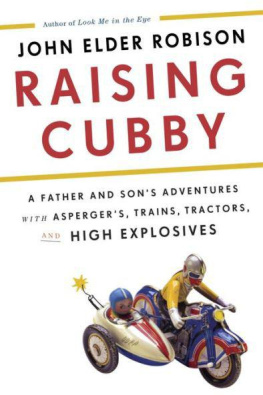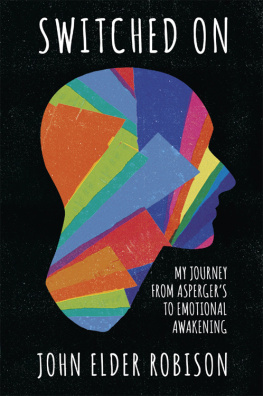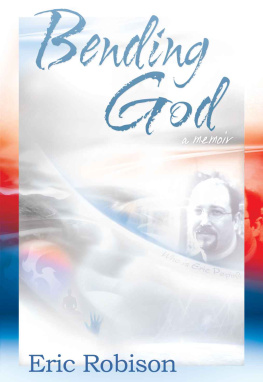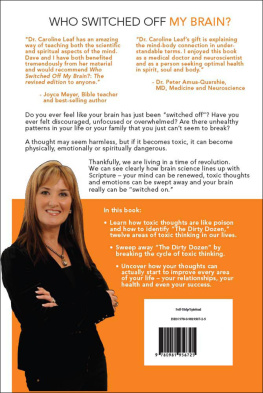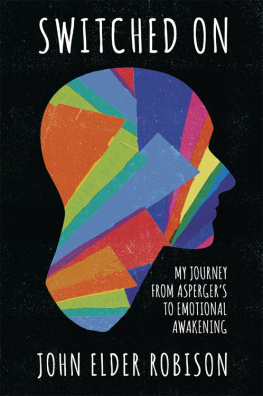John Elder Robison - Switched On: A Memoir of Brain Change and Emotional Awakening
Here you can read online John Elder Robison - Switched On: A Memoir of Brain Change and Emotional Awakening full text of the book (entire story) in english for free. Download pdf and epub, get meaning, cover and reviews about this ebook. year: 2016, publisher: Spiegel & Grau, genre: Science. Description of the work, (preface) as well as reviews are available. Best literature library LitArk.com created for fans of good reading and offers a wide selection of genres:
Romance novel
Science fiction
Adventure
Detective
Science
History
Home and family
Prose
Art
Politics
Computer
Non-fiction
Religion
Business
Children
Humor
Choose a favorite category and find really read worthwhile books. Enjoy immersion in the world of imagination, feel the emotions of the characters or learn something new for yourself, make an fascinating discovery.

- Book:Switched On: A Memoir of Brain Change and Emotional Awakening
- Author:
- Publisher:Spiegel & Grau
- Genre:
- Year:2016
- Rating:3 / 5
- Favourites:Add to favourites
- Your mark:
- 60
- 1
- 2
- 3
- 4
- 5
Switched On: A Memoir of Brain Change and Emotional Awakening: summary, description and annotation
We offer to read an annotation, description, summary or preface (depends on what the author of the book "Switched On: A Memoir of Brain Change and Emotional Awakening" wrote himself). If you haven't found the necessary information about the book — write in the comments, we will try to find it.
Switched On: A Memoir of Brain Change and Emotional Awakening — read online for free the complete book (whole text) full work
Below is the text of the book, divided by pages. System saving the place of the last page read, allows you to conveniently read the book "Switched On: A Memoir of Brain Change and Emotional Awakening" online for free, without having to search again every time where you left off. Put a bookmark, and you can go to the page where you finished reading at any time.
Font size:
Interval:
Bookmark:
Acknowledgments
IN THIS BOOK, Ive done my best to translate some very complex science into something the average person can understand. I could never have done that without the help of the people listed in this section. When you read this list of credits, consider how all the people are tied together with multiple threads of connectivity, just like the strands in our brains....
The first person I would like to thank is former Elms College president James H. Mullen, Jr. Dr. Mullen is now president of Allegheny College and chairman of the American Council on Education. He got this story started by inviting me to the Elms, where Dr. Kathryn James welcomed me into their autism programme. If not for them, Id never have met Lindsay....
I will always be indebted to Dr. Alvaro Pascual-Leone, his postdocs Lindsay Oberman, Ilaria Minio-Paluello, Shirley Fecteau, and all the other staff of the Berenson-Allen Center for Noninvasive Brain Stimulation at Bostons Beth Israel Deaconess Medical Center. They are all bright, compassionate, and driven researchers. Alvaro is still very active in TMS research, and his clinic has developed a significant therapeutic practice in Boston. He remains one of the worlds leading TMS researchers.
In addition to heading the TMS lab, Alvaro is a professor in Neurology and the associate dean for clinical and translational research at Harvard Medical School.
Lindsays work earned her a lab of her own. Today she is director of the Neuroplasticity and Autism Spectrum Disorder Program at Bradley Hospital, the scientific director of the clinical TMS programme at Rhode Island Hospital, and an assistant professor in the Department of Psychiatry at the Warren Alpert Medical School of Brown University in Providence, Rhode Island. She works with TMS and autism and collaborates with Alvaro and others at Beth Israel, Boston Childrens, and Harvard.
Shirley moved back to Canada after her postdoc at Harvard. She currently holds a Canada Research Chair in Human Cognition, Decision-making, and Brain Plasticity at Laval University in Quebec. Much of her work today is focused on the use of TMS and other noninvasive brain stimulation techniques to help people with addictions.
Ilaria returned to Rome after her postdoc, where she joined the faculty of Sapienza University. She continues to be interested in TMS and autism, and I was pleased to visit her in Rome with my wife, Maripat, in the fall of 2012.
After getting involved with those Harvard scientists, I relied on my radiologist friend David Rifken, MD, to explain MRI and other brain imaging and the strange dots on my brain scans, and to answer a million other bizarre questions. Dave is a senior radiologist at Cooley Dickinson Hospital of Northampton, a Massachusetts General Hospital affiliate. Thanks again for being my friend and reading my brain scans (and all the others over the years!).
Thanks to Kimberley Hollingsworth Taylor, Michael, Nick, and family for accompanying me on the TMS journey, and for contributing memories to this account.
Id also like to thank Dr. Nancy Minshew and Dr. Marcel Just at the University of Pittsburgh Autism Center and Carnegie Mellon University. The work they are doing is truly mind expanding and I cannot thank you enough for inviting my wife and me to be part of it.
Dr. Manny Casanova and his wife, Dr. Emily Casanova, are important people in the world of TMS and (at the time of my TMS experiences) at the University of Louisville. Both played a big role in the background by helping me understand TMS and the workings of the mind, and I greatly appreciate their contributions. Manny now holds the SmartState Endowed Chair in Translational Neurotherapeutics. Hes a professor of biomedical sciences at the University of South Carolina School of Medicine Greenville.
He is also the closest thing I know to a Renaissance man of neuroscience. While I describe researchers like Lindsay as users of TMS technology, Manny is a guy who does not hesitate to roll up his sleeves and go into the guts of the machine to get what he wants from it. As Ive gotten to know him these past six years, Ive often wished we lived closer together. He agreed, saying, We would have enjoyed spending some time together building our own TMS machine with a bank of super capacitors, trying not to shock ourselves, and examining the resultant brain-wave changes as if they were on an oscilloscope.
Peter Enticott has also weighed in on this story, and Id like to recognize his contribution here. Peter helped out in the background for the American edition of this book, and wrote a foreword for the Down Under edition. Hes a professor of cognitive neuroscience at Deakin University in Melbourne, Australia, and another top TMS scientist.
Next Id like to thank Dr. Geri Dawson for asking me to get involved in autism science and then serving as a guide and mentor as I found my way. When I began my NIH service I was supported by everyone I metfrom National Institute of Mental Health director Dr. Thomas Insel, to National Institute of Child Health and Human Development director Dr. Alan Guttmacher, Office of Autism Research Coordination head Dr. Susan Daniels, and all the members of the Interagency Autism Coordinating Committee with whom Ive had the honour of serving since 2012.
At the Centers for Disease Control and Prevention I was encouraged by Dr. Marshalyn Yeargin-Allsopp, Dr. Cathy Rice, and many others. Whenever I have a question you are always there, and I hope Ive been able to reciprocate by my work on your committees.
Five years ago, Geri suggested I offer an autistic persons perspective to the scientists of INSAR, the International Society for Autism Research. Today I am a voting member of INSAR and a member of its governing committees. I speak up for the role of autistic people in guiding research for and about us. Id like to express my thanks to all of the INSAR members who have spent time talking to me and encouraging me on this journey.
Lisa Greenman deserves special thanks for connecting me to the Ivymount School in 2008. Lisa is a federal public defender with a focus on defending people with developmental disabilities. It was she who counselled me to speak up for autistic people who are unfairly charged with crimes by ignorant or misguided prosecutors.
Monica Adler Werner at the Ivymount School showed me what an autism school can be, as did Dr. Marty Webb of Monarch School in Houston, Texas. Both of you have inspired me more than you know, with the evidence being the high school programme in our car complex today.
Monica turned out to be involved with a team of researchers at the Childrens National Medical Centers Center for Autism Spectrum Disorders who wanted to find practical ways to help kids on the spectrum. Medical research is fine, she told me, but we still have to teach kids how to get by in the world right now. It turned out they were developing a curriculum called Unstuck and testing it in classrooms at her school. What I saw was so impressive that I wrote a foreword for the Unstuck and On Target! book, and I recommend it wherever I go. Next year, we hope to begin testing the Unstuck techniques at William & Mary.
Id like to thank everyone at the College of William & Mary, particularly history professor Karin Wulf, who first brought me there, provost Michael Halleran, who believed in neurodiversity at a time when the word was unknown in higher education. Thanks to Joel Schwartz, director of the Charles Center and dean of honours and interdisciplinary studies, for welcoming me into his college. Id also like to recognize my other colleagues in the neurodiversity programmeProfessors Josh Burk, Cheryl Dickter, Warenneta Mann, and Janice Zeman. Im proud to be associated with all of you. Thanks also to the Aronow Foundation for their support of W&Ms neurodiversity effort.
Next pageFont size:
Interval:
Bookmark:
Similar books «Switched On: A Memoir of Brain Change and Emotional Awakening»
Look at similar books to Switched On: A Memoir of Brain Change and Emotional Awakening. We have selected literature similar in name and meaning in the hope of providing readers with more options to find new, interesting, not yet read works.
Discussion, reviews of the book Switched On: A Memoir of Brain Change and Emotional Awakening and just readers' own opinions. Leave your comments, write what you think about the work, its meaning or the main characters. Specify what exactly you liked and what you didn't like, and why you think so.

